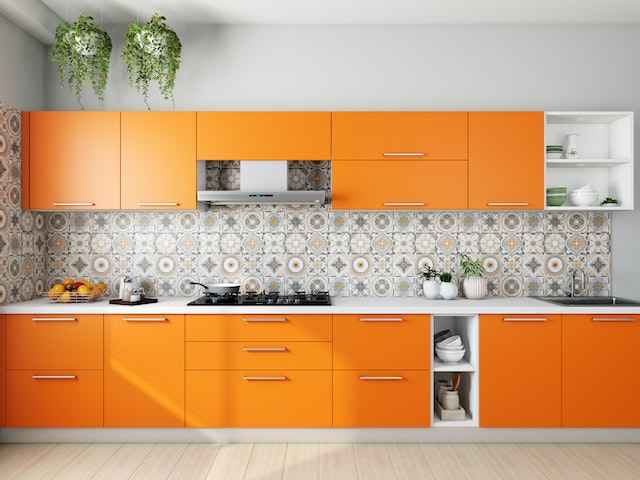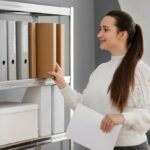On average, the approved weight capacity for wall kitchen cabinets is 600 pounds (272.155 kilograms), according to the Kitchen Cabinet Manufacturers Association.
However, this varies depending on the different parts of the cabinet.
Most kitchen cabinet manufacturers voluntarily set their own standards and guarantees for cabinet weight capacity not exceeding 500 pounds.
Custom builders don’t typically list cabinet ratings, but the integrity of almost any custom cabinet usually exceeds standards.
Here are some weight capacities for different types of kitchen cabinets:
- Pantry shelves: 45 to 100 pounds
- Base kitchen cabinets: 150 to 200 pounds
- Lazy kitchen cabinets: up to 70 pounds
- Metal or steel kitchen cabinets: up to 500 pounds
Keep in mind that these weight capacities depend on various factors, such as the quality of the cabinets, the materials used, and the fasteners.
It’s essential to avoid overburdening your cabinets to prevent damage or accidents.
Are There Any Specific Factors That Can Affect The Weight Capacity Of Kitchen Cabinets?
Yes, there are specific factors that can affect the weight capacity of kitchen cabinets.
These factors include the material, size, design, and installation of the cabinets.
The width and depth of a kitchen cabinet also contribute to its strength or weakness, with a shallow-depth or wide cabinet being weaker than one built with more lumber and materials because it has less structural integrity.
The material of the cabinets also plays a significant role in determining their weight capacity, with wooden cabinets being stronger and more durable than laminate cabinets, and metal cabinets being stronger than wooden or laminate cabinets.
It’s important to consult the manufacturer’s specifications or seek professional advice to determine the weight capacity of a specific cabinet.
The Kitchen Cabinet Manufacturers Association also provides approval and manufacturer-imposed weight limits for kitchen cabinets.
How Can I Determine The Weight Of Items I Plan To Store In My Kitchen Cabinets?

Determining the weight of items you plan to store in your kitchen cabinets can be challenging, as it depends on the size and material of the cabinets.
However, there are some resources that can help you estimate the weight capacity of your cabinets.
According to Kitchen Cabinet Standards, most kitchen cabinet manufacturers dictate their own weight limits, and 500 pounds is more common.
If you’re having custom wood kitchen cabinets built, they won’t come with a manufacturer’s suggested weight limit.
Another resource is The Kitchen Cabinet Manufacturers Association, which provides approval for kitchen cabinets based on their weight capacity.
To get an idea of the weight of your items, you can use a household furniture weight calculator.
However, keep in mind that this will only provide an estimate and may not be accurate.
It’s also important to measure your cabinets accurately to ensure they can support the weight of your items.
To measure your cabinets, determine the height, width, and depth of each cabinet using a tape measure.
Keep in mind that even if a cabinet looks like a single unit, it may be made of multiple cabinets that each have their own width.
Can I Reinforce Or Modify My Kitchen Cabinets To Increase Their Weight Capacity?
Yes, it is possible to reinforce or modify kitchen cabinets to increase their weight capacity.
The weight capacity of a kitchen cabinet depends on several factors, including the material, size, design, and installation.
According to the Kitchen Cabinet Manufacturers Association, the average kitchen cabinet can hold 600 pounds or 272 kilograms, but most wall cabinets would carry a minimum of 500 pounds or 226 kilograms of weight.
However, there is no set standard for kitchen cabinet weight capacity because there are too many variables that affect its sturdiness.
To reinforce kitchen cabinets, one can install angled metal hardware in areas that are bending or need support, replace or tighten moving parts, support the empty space underneath floor cabinets, and securely attach the backs of cabinets to the wall.
It is always best to consult the manufacturer’s specifications or seek professional advice to determine the weight capacity of a specific cabinet or shelf.
What Are Some Common Signs Of Overburdened Cabinets, And How Can I Address The Issue?
Some common signs of overburdened cabinets include sagging shelves, doors that don’t close properly, and cracks in the cabinet frame.
If you notice any of these signs, it’s important to address the issue to prevent further damage to your cabinets and ensure the safety of your household.
One way to address the issue is to declutter your cabinets and remove any unnecessary items that are adding weight.
You can also redistribute the weight by moving heavier items to lower shelves or cabinets that are better equipped to handle the weight.
If the issue persists, you may need to consider replacing your cabinets or reinforcing them with additional support, such as brackets or braces.
It’s important to keep in mind the weight capacity of your cabinets, which can vary depending on factors such as the type of cabinet and the materials used.
If you’re unsure about the weight capacity of your cabinets, you can consult with a professional or refer to the manufacturer’s guidelines.
Are There Any Alternative Storage Solutions Or Strategies For Heavy Items That Exceed The Weight Capacity Of Kitchen Cabinets?
Yes, there are alternative storage solutions or strategies for heavy items that exceed the weight capacity of kitchen cabinets.
Here are some ideas:
- Use storage containers: There are many types of storage containers available that can hold heavy items.
For example, Home Depot’s HDX Tough Storage Totes are stackable and come in various sizes. - Use zippered bags: Store hardware or small items in small, sturdy zippered craft bags and hang them on the pegboard.
- Use shipping containers: Buying used shipping containers is a rising trend for storage solutions.
- Use crawl spaces and basements: These areas can be used for storage with waterproof boxes.
- Use other furniture: Other furniture, such as bookshelves or dressers, can be used for storage of heavy items.
- Use wall-mounted shelves: Wall-mounted shelves can be used to store heavy items and free up floor space.
- Use under-bed storage: Under-bed storage containers can be used to store heavy items and free up closet space.







